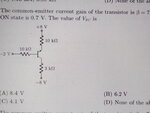ABEL DANIEL
Member level 2

For this i have have a SOLUTION.But i have a doubt in the solution:
Here,base current is found by applying KVL to i/p loop and then
Then Ic =βIb and then Ie=gamma Ib=(β+1)Ib
So Rc is found by applying KVL to output loop
My question is, can we apply formulas like Ic=alpha* Ie(like one,that we used here),Ic=βIb and Ie=gamma*Ib,blindly in every problem;dont we need to find the region of operation(active,cutoff and sat)first,before applying these formulas?
Last edited: